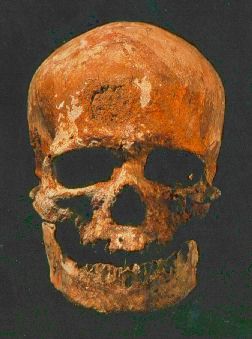Copyright © Jim Foley || Email me

 Discovered by workmen in 1868 at Cro-Magnon, in the village of Les Eyzies in France.
The estimated age of the site is 30,000 years. The site yielded 5 skeletons (3 adult
males, an adult female, and a child) which had been buried there, along with stone tools, carved reindeer
antlers, ivory pendants, and shells. The Cro-Magnons lived in
Europe between 35,000 and 10,000 years ago. They are virtually
identical to modern man, being tall and muscular and slightly
more robust on average than most modern humans. They were skilled hunters,
toolmakers and artists famous for the cave art at places such as Lascaux, Chauvet,
and Altamira.
Discovered by workmen in 1868 at Cro-Magnon, in the village of Les Eyzies in France.
The estimated age of the site is 30,000 years. The site yielded 5 skeletons (3 adult
males, an adult female, and a child) which had been buried there, along with stone tools, carved reindeer
antlers, ivory pendants, and shells. The Cro-Magnons lived in
Europe between 35,000 and 10,000 years ago. They are virtually
identical to modern man, being tall and muscular and slightly
more robust on average than most modern humans. They were skilled hunters,
toolmakers and artists famous for the cave art at places such as Lascaux, Chauvet,
and Altamira.
The skull at right is Cro-Magnon 1, is a male with a brain size of 1600 cc, some 200 cc larger than the average modern human.
If Cro-Magnons were modern humans, does that mean that modern humans are Cro-Magnons? Not really. Logically, many modern humans should be, since most modern Europeans are probably descended from them. But the term has no taxonomic significance and usually just refers to Europeans in a certain time range, even though other modern humans were living throughout much of the world at the same time. To quote the Oxford Companion to Archaeology:
Cro-magnons are, in informal usage, a group among the late Ice Age peoples of Europe. The Cro-Magnons are identified with Homo sapiens sapiens of modern form, in the time range ca. 35,000-10000 b.p. ...The term 'Cro-Magnon' has no formal taxonomic status, since it refers neither to a species or subspecies nor to an archaeological phase or culture. The name is not commonly encountered in modern professional literature in English, since authors prefer to talk more generally of anatomically modern humans. They thus avoid a certain ambiguity in the label 'Cro-Magnon', which is sometimes used to refer to all early moderns in Europe (as opposed to the preceding Neanderthals), and sometimes to refer to a specific human group that can be distinguished from other Upper Paleolithic humans in the region. Nevertheless, the term 'Cro-Magnon' is still very commonly used in popular texts because it makes an obvious distinction with the Neanderthals, and also refers directly to people rather than to the complicated succession of archaeological phases that make up the Upper Paleolithic. This evident practical value has prevented archaeologists and human paleontologists - especially in continental Europe - from dispensing entirely with the idea of Cro-Magnons.
The creationist tract Big Daddy, and many other creationists who have copied from it, have the following to say about Cro-Magnon Man:
Cro-Magnon Man - One of the earliest and best established fossils is at least equal in physique and brain capacity to modern man... so what's the difference?D'oh! To the best of my knowledge, no one has ever claimed there was a difference.
My thanks to Doug Weller for finding the quote from Oxford Companion to Archaeology and posting it on the talk.origins newsgroup.
This page is part of the Fossil Hominids FAQ at the talk.origins Archive.
Home Page |
Species |
Fossils |
Creationism |
Reading |
References
Illustrations |
What's New |
Feedback |
Search |
Links |
Fiction
http://www.talkorigins.org/faqs/homs/cromagnon.html, 11/30/2002
Copyright © Jim Foley
|| Email me 